
If you're taking AP Biology, it's a good idea to familiarize yourself with the exam before you get too far into the course. Preparing ahead of time for the AP exam format and fully understanding what concepts are covered on the AP Biology test can go a long way toward earning a high score (and potentially getting college credit!).
This article will take you through the structure and scoring of the AP Bio exam and give you some key tips on the best ways to study for AP Biology.
How Is the AP Biology Exam Structured?
The AP Biology test is three hours long and has two sections: a multiple-choice section and a free-response section.
The next AP Biology exam will take place on Wednesday, May 11, 2022, at 12 p.m. If there are widespread school closures due to COVID around this time, the College Board will offer digital testing like they did in 2021.
Differences Between the Paper and Digital AP Biology Exams
As of 2022, the College Board has returned to paper-and-pencil testing in most instances. Digital exams will only be available on a case-by-case basis if there are school closures due to COVID-19 this spring.
If you& ;do end up taking a digital exam due to COVID-19, here's what you need to know:
Of the differences between the two exam versions, the College Board states, "On the digital exam, students will answer free-response questions with a keyboard, rather than by hand. Students taking digital exams will not be asked to draw or graph as part of their response—rather, these skills will be assessed with questions about given graphs or other stimuli. The digital exam app will include any symbols students would need to type their responses."
Again, digital examinations will be very limited in 2022, so it's a good idea to prepare for a paper-and-pencil test!
Multiple-Choice Section
The first section on AP Bio consists of all multiple-choice questions. Here's an overview of what to expect:
- 60 multiple-choice questions, each with four answer choices (A-D)
- 90 minutes long
- Worth 50% of your score
You'll get a mix of both stand-alone questions and questions in sets, with four to five questions per set.
Until 2020, the AP Bio test also included grid-in questions in its multiple-choice section, but these have since been removed. This means that you don't need to worry about not being able to come up with the right answer—it'll always be one of the four answer choices given to you!
Free-Response Section
The second section on AP Bio is the free-response section, which looks like this:
- Two long-response questions, both with a focus on analyzing experimental results
- Four short-answer questions on the following topics in this order:
- Scientific Investigation
- Conceptual Analysis
- Analysis of a Model or Visual Representation
- Data Analysis
- 90 minutes long
- Worth 50% of your score
Long questions are worth 8-10 points each, whereas short-answer questions are worth 4 points each. Note that the second long question will require you to graph something as well.
Until 2020, the AP Bio exam had six short-answer questions (instead of the current four).
Expectations of the AP Biology Exam
Here's what both sections on the AP Biology test expect you to know how to do:
- Understand how graphical and mathematical models can be used to explain biological principles and concepts
- Make predictions and justify events based on biological principles
- Implement your knowledge of proper experimental design
- Interpret data
 Is this coffee smiling at me? Or am I delirious from lack of sleep?
Is this coffee smiling at me? Or am I delirious from lack of sleep?
What's Tested on the AP Biology Exam? 4 Big Ideas
The AP Biology test doesn't include a set number of questions that deal with each topic area, but you should note that the exam is centered around four major themes (or "Big Ideas," as the College Board calls them). Here's a list of these themes, followed by some of the topics that fall beneath each of them.
Big Idea 1: Evolution
The process of evolution drives the diversity and unity of life. Topics that fall into this category include the following:
- Natural selection
- Artificial selection
- Mathematical modeling of populations
- Species classification
- Biodiversity and Ecosystems
- Origins of cell compartmentalization
- Genetics
Big Idea 2: Energetics
Biological systems use energy and molecular building blocks to grow, reproduce, and maintain dynamic homeostasis. Topics that fall into this category include the following:
- Molecular biology
- Cell structure
- Photosynthesis
- Cellular respiration
- Thermodynamics and homeostasis
- Immune response
Big Idea 3: Information Storage and Transfer
Living systems store, retrieve, transmit, and respond to information essential to life processes. Here are the main topics in this category:
- DNA, RNA, and gene expression
- Cell cycle (mitosis and meiosis)
- Viruses
- Communication between cells
- Endocrine system
- Nervous system
Big Idea 4: Systems Interaction
Biological systems interact, and these systems and their interactions exhibit complex properties. The topics that fall into this category include the following:
- Plant structure
- Enzymes
- Circulatory system
- Digestion
- Musculoskeletal system
- Ecology
AP Biology Sample Questions
Now that you have a basic content outline, here are some examples of the types of questions you'll see on the AP Biology test so that you can get an even better idea of what to expect.
Multiple-Choice Sample Question
Here is an example of a multiple-choice AP Biology exam question:
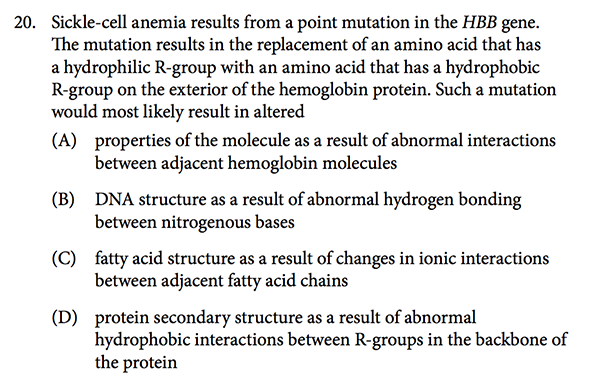
This question looks kind of complicated, but let’s break it down. The first sentence is background information that isn’t really necessary for answering the question, besides the fact that it tells us we’re talking about sickle cell anemia. This is helpful if you can remember basic facts about the disease that you can use to contextualize the question.
The main part of the question asks what will be affected when you replace a hydrophilic amino acid with a hydrophobic one on a hemoglobin protein. Based on your knowledge of sickle cell anemia and molecular properties, you should be able to eliminate choices B and C, which don’t have much to do with the abnormality described in the question.
Choice D can also be eliminated because the internal secondary structure of the protein is not altered by the existence of the hydrophobic group.
This would only affect how the molecule interacts externally with other hemoglobin molecules, as in choice A (the correct answer).
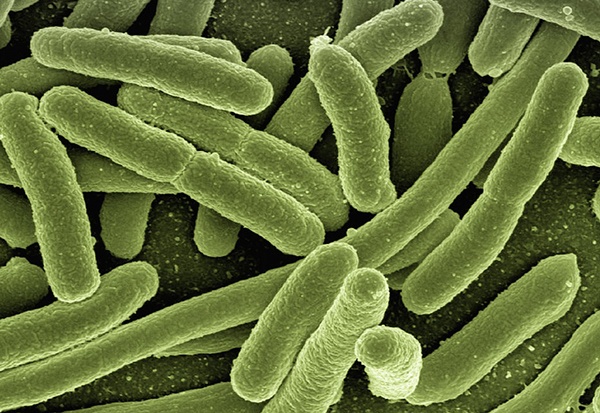
Bacteria gettin' it on.
Free Response: Long Sample Question
Here’s an example of a long free-response question you might see on the AP Biology exam:
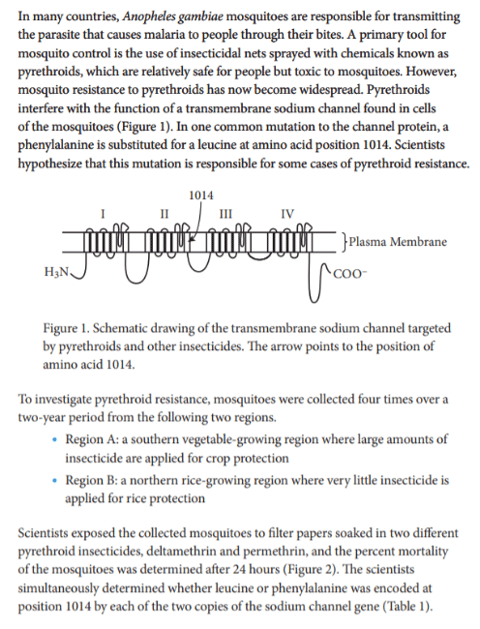
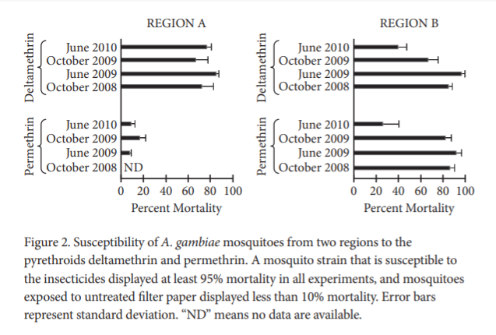
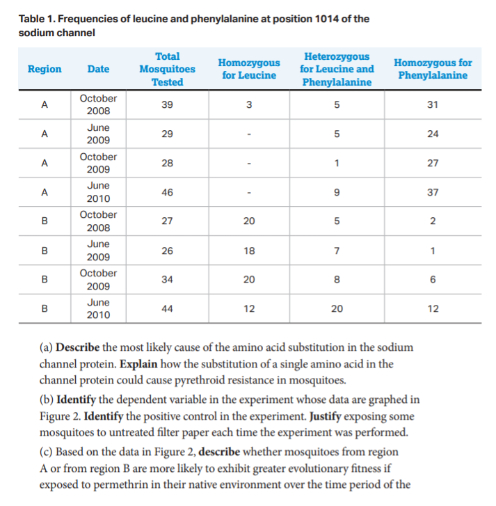
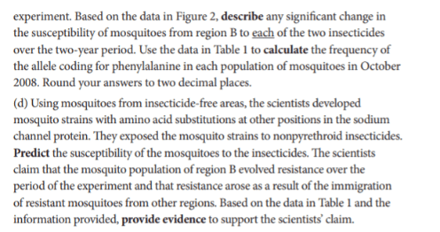
That's one long question! Now, this AP Bio question is worth a total of 8-10 points (the AP Biology Exam Description doesn't specify exactly how much this particular sample question is worth).
As you can see, there are four distinct parts: A, B, C, and D. Each part asks you to do something different and is worth a certain number of points:
- Part A is worth 1-2 points. To earn these points, you must describe and explain the specific biological process or concept at play (here, that would be the amino acid substitution and its effect on the mosquitoes).
- Part B is worth 3-4 points. You must identify experimental design procedures (in this case, that would be the dependent variable and the positive control).
- Part C is worth 1-3 points. To get these points, you must analyze specific data given to you. In this example, that would be the data in Figure 2 (the second image in the problem) and in Table 1.
- Part D is worth 2-4 points. You have to make and justify your predictions to earn full points here; this means you must provide clear evidence for your claim. In this sample problem, for example, you would have to write about how susceptible you think the mosquitoes will be to the insecticides while also backing up your claim with evidence from Table 1 and other data.
 Ugh, gross! This leaf is full of trichomes.
Ugh, gross! This leaf is full of trichomes.
Free Response: Short-Answer Sample Question
Here’s an example of a short-answer question you might see on the AP Biology test free-response section:

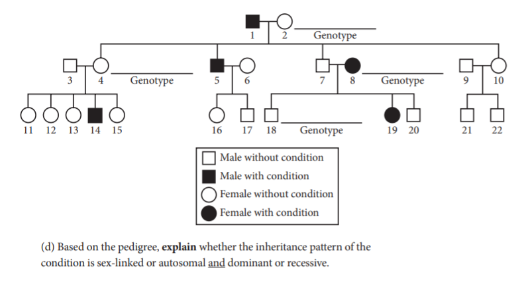
This short-answer free-response AP Bio question is an example of an Analysis of a Model or Visual Representation problem (always #5 out of your six free-response questions). It is worth a total of 4 points (as are all short-answer questions).
Like the long-form question above, each short-answer question consists of four parts: A, B, C, and D. You must answer all of these to get full points.
- Part A is worth 1 point. To get this first point, you'll need to describe the characteristics of the biological process, concept, or visual model in the problem. With this particular question, you must understand the process of fertilization and how chromosomes do not double.
- Part B is worth 1 point. For this point, you'll have to explain the relationships between two biological concepts or processes in the problem. In the sample above, this means you must explain the genetic relationship between individual 16 and individuals 1 and 2.
- Part C is worth 1 point. To earn this point, you must represent biological relationships in a model. For this problem, you would need to simply fill in the blanks in the template.
- Part D is worth 1 point. To get this final point, you would need to draw a clear connection between the biological concept/process in the problem and a larger biological principle or theory. For the question above, you would have to understand the intricacies of inheritance patterns and what role chromosomes play in them.
 There must be jobs out there for which you just have to collect plant samples. Start building your experience now by never showering.
There must be jobs out there for which you just have to collect plant samples. Start building your experience now by never showering.
How Is the AP Biology Exam Scored?
As mentioned, on the AP Bio test, the multiple-choice section makes up 50% of your score and the free-response section makes up the other 50%.
For the multiple-choice section, it’s easy to calculate your raw score: you just get 1 point for each question you answer correctly. There are no point deductions for incorrect or blank answers.
Scoring is a bit more complicated on the free-response section, which is scored by actual graders rather than a computer. Each of the four short-answer questions is scored out of 4 points, and each long free-response question is scored from 8 to 10 points.
To figure out your final AP Bio score on a scale of 1-5, you’ll need to do a couple more calculations. This can change from year to year based on the performance of students.
This is the most recent info regarding the methodology behind AP Bio scoring. You can also use our calculations below:
- Multiply the number of points you got on the multiple-choice section by 1.03
- Multiply the number of points you got on the two long free-response questions by 1.5
- Multiply the number of points you got on the short free-response questions by 1.43
- Add all these numbers together to get your raw AP Biology score
Here's a conversion chart you can use to see how raw score ranges (generally) translate into final AP scores.
We've also included the percentage of students who earned each score in 2021 to give you an idea of what the score distribution looks like:
| Raw Score | AP Score | % of Test Takers Earning Score (2021) |
| 92-120 | 5 | 7.4% |
| 72-91 | 4 | 19.4% |
| 52-71 | 3 | 32.4% |
| 31-51 | 2 | 30.0% |
| 0-30 | 1 | 10.8% |
For example, if you got 40 points on the multiple-choice section (on the old AP Bio exam), 13 points on the long-response questions, and 14 points on the short-response questions, your AP Bio score would be (40 * 1.03) + (13 * 1.5) + (14 * 1.43) = 80.72. This indicates that you'd likely earn a 4 on the AP Biology test.
 If you want to spice things up a little bit, you can even do the math on a snazzy calculator with red buttons! Isn't this fun?!?!?
If you want to spice things up a little bit, you can even do the math on a snazzy calculator with red buttons! Isn't this fun?!?!?
The Best Way to Prep for the AP Biology Exam: 4 Key Tips
Now that you know all about what's on the AP Biology test, it's time to learn how to ace it. Follow these four tips so you can get a great score!
Tip 1: Review Your Labs
Labs make up 25% of the AP Biology course, and for good reason. It’s important to understand how labs are conducted and how the principles behind them relate to the main ideas of the course. This will help in answering both free-response and multiple-choice questions that deal with lab scenarios on the test.
Many free-response questions ask you to identify the components of a proposed experiment (dependent and independent variables) or to design a lab to test a certain hypothesis. You might have forgotten about the labs you did toward the beginning of the year, so take extra care to go over them. Make sure that you understand exactly how they were conducted and what the results mean.
Tip 2: Learn to Connect Small-Scale Terms With Large-Scale Themes
As we discussed above, the AP Biology test covers four major themes, or Big Ideas:
- Evolution
- Energetics
- Information storage and transfer
- Systems interactions
Under each of these umbrella topics are many terms and ideas you'll need to review.
Memorization can be a big part of studying for AP Biology. However, memorizing the definitions of terms will only get you so far. You'll also need to understand how they relate to one another and to the four themes listed above.
The exam emphasizes making connections between biological terms, corresponding biological systems, inputs and outputs of these systems, and the overall impact on living organisms and the environment. You should be able to follow a chain of reasoning from the specific to the broad, and vice versa.
 If this tree is AP Biology, the four big branches are the four themes and all the smaller offshoots are different terms and concepts. For it to survive, there has to be a lot of communication between the trunk and the rest of the tree!
If this tree is AP Biology, the four big branches are the four themes and all the smaller offshoots are different terms and concepts. For it to survive, there has to be a lot of communication between the trunk and the rest of the tree!
Tip 3: Practice Eliminating Irrelevant Information
Both multiple-choice and free-response AP Biology questions include lots of scientific terminology and visual aids, and this kind of format might be intimidating if you’re not used to it. It’s important to practice sorting through this jumble of information so that you can quickly get to the root of the question rather than obsessing over small details you don’t understand.
Try underlining important words and phrases in the question to help you stay focused on the main points and avoid misleading distractions.
You should also practice responding to free-response questions in a straightforward way without any unnecessary fluff. Remember, this isn’t an English test; the graders are just looking for clear facts and analysis. Make it easy for them to give you points!
Tip 4: Learn Good Time Management
The AP Bio exam is pretty long (even for an AP test), and many of the questions require quite a bit of thought. You need to ensure that you have a good handle on time management before exam day. The best way to do this is to take at least one AP Biology practice test.
The most recent one available is from 2013, so it's a little out of date and follows the old format of the AP Bio exam; however, it should still be pretty useful overall. There are 58 questions in total on the multiple-choice section (including five grid-ins, which you can skip as these aren't on the AP Bio test anymore), and you have 90 minutes to answer them. This comes out to about one minute and 40 seconds for each question.
Therefore, you should spend no more than a minute and 15 seconds on each multiple-choice question when you go through this practice test. If you find yourself spending extra time on a question, skip it and come back to it later. It’s best to give yourself some leeway in case you run into any difficult questions later on.
You also have 90 minutes for the free-response section, but you'll spend different amounts of time on the long and short questions. Go ahead and skip two of the short-answer questions because now the AP Bio exam only has four instead of six.
Next, be sure to limit your time on the long questions to about 20 minutes each (40 minutes total), and your time on the short questions to eight or nine minutes each or less. If you can’t work this fast right away, try doing some additional practice free-response questions until you feel comfortable with the time constraints.
 Really get to know the test. Take it on a romantic getaway, and watch the sunset with it. Deep down, the AP Biology exam just wants to be understood.
Really get to know the test. Take it on a romantic getaway, and watch the sunset with it. Deep down, the AP Biology exam just wants to be understood.
Summary: How to Do Well on the AP Biology Exam
The AP Biology exam is three hours long, with two sections that take up an hour and a half each. The multiple-choice section has 60 questions, and the free-response section has six questions.
The content of the exam spans four major themes, or Big Ideas, that are central to the course. These include the following:
- Evolution
- Energetics
- Information storage and transfer
- Systems interactions
Questions ask you to connect specific terms and concepts to these central topics. They'll test your ability to interpret data, make predictions and inferences based on evidence, and analyze different experimental scenarios.
Overall, AP Biology is a tough test, but as long as you study hard and know what to expect, you're perfectly capable of getting a great score! You can also head on over to the College Board's AP Classroom tool for AP Biology, which has tons of resources and information.
What's Next?
Review key biology ideas and facts with our subject-focused guides. You'll learn about cell theory and the functions of the cell membrane and endoplasmic reticulum, what the distinction is between homologous and analogous structures, how enzymes work, and when and how to use the photosynthesis equation.
Still planning out your class schedule? Find out how many AP classes you should take in high school based on your college goals.
The difficulty level of different AP classes might play a role in your decision whether or not to take them. Check out these articles for more info on which AP classes are the hardest and which are the easiest.
Have friends who also need help with test prep? Share this article!

Samantha is a blog content writer for PrepScholar. Her goal is to help students adopt a less stressful view of standardized testing and other academic challenges through her articles. Samantha is also passionate about art and graduated with honors from Dartmouth College as a Studio Art major in 2014. In high school, she earned a 2400 on the SAT, 5's on all seven of her AP tests, and was named a National Merit Scholar.



































 Holly R.
Holly R.